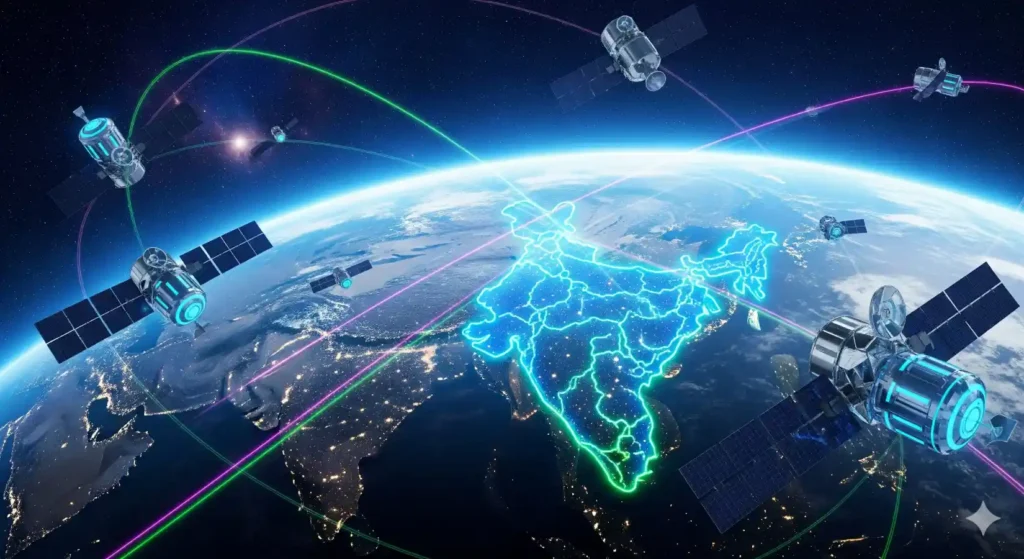India could soon be stepping into the era of satellite-powered internet. Elon Musk’s Starlink, operated by SpaceX, is reportedly gearing up to start trials in India, with discussions underway with telecom giants Reliance Jio, Bharti Airtel, and Tata Group.
If these trials take off, India’s long struggle to bring fast and reliable internet to its rural and remote regions might finally see a breakthrough. But with regulations, pricing, and competition in the mix, the journey won’t be without challenges.

Key Highlights
- Elon Musk’s Starlink is preparing to begin satellite internet trials in India.
- Talks are ongoing with major telecom operators: Jio, Airtel, and Tata.
- Goal: expand high-speed internet access to rural and remote areas.
- India will join the list of countries testing low-earth orbit (LEO) satellite broadband.
- Regulatory approvals and pricing remain the biggest challenges.
What Is Starlink and Why It Matters
For those unfamiliar, Starlink is SpaceX’s satellite internet project that uses a network of low-earth orbit (LEO) satellites to provide broadband connectivity. Unlike traditional satellites orbiting thousands of kilometers above Earth, Starlink’s LEO satellites operate much closer (about 550 km away).
This lower altitude reduces latency (the delay in data transfer) and allows Starlink to deliver speeds comparable to fiber broadband in many regions.
Globally, Starlink is already available in over 70 countries, serving users in rural America, parts of Europe, Australia, and Africa. It has become especially popular in places where traditional broadband networks are hard to build.
Starlink Trials in India: The Latest Update
According to reports, Starlink is holding infrastructural discussions with Indian telecom operators including Jio, Airtel, and Tata. These talks focus on building partnerships for ground infrastructure, spectrum sharing, and local distribution.
The aim is to run pilot trials before a wider commercial rollout. If successful, these trials will bring Starlink’s satellite internet to select Indian regions—most likely in underserved rural areas where fiber and 5G coverage are limited.
While there’s no official timeline yet, industry experts suggest the trials could begin in the near future, once regulatory approvals are in place.
Why Indian Telecom Giants Are Key
Starlink cannot enter India as a completely independent player due to local regulatory requirements. To legally provide services, it needs local partners for ground stations, licensing, and customer support.
- Reliance Jio: Already leading in mobile and fiber broadband, Jio could help expand Starlink’s reach.
- Airtel: Through its investment in OneWeb, Airtel already has a stake in satellite internet and may become both a competitor and collaborator.
- Tata Group: With its telecom arm and satellite experience, Tata could provide Starlink with the local infrastructure backbone.
These partnerships are not just strategic but necessary for Starlink to succeed in India.
📖 Read More from SameerTech.in
What Starlink Means for Indian Users
If Starlink becomes available, it could transform connectivity in India:
- Rural Reach: Areas without fiber or 5G towers could finally get reliable broadband.
- Education & Healthcare: Students in villages could access online classes, and remote clinics could use telemedicine.
- Business Growth: Small businesses in remote towns could join the digital economy.
However, challenges remain. The price of Starlink hardware and subscription is significantly higher than regular broadband. While affordable in Western markets, in India it could be out of reach for the average household unless subsidized or adapted for local pricing.
Another limitation is weather dependency—heavy rains or storms can impact satellite signals, though Starlink’s newer hardware is improving reliability.
Starlink vs Existing Internet Options in India
India already has a mix of fiber broadband (JioFiber, Airtel Xstream, BSNL) and 5G Fixed Wireless Access (FWA) options.
- Fiber Broadband: Offers high speeds at lower costs, but only in urban and semi-urban areas.
- 5G FWA: Still rolling out, with potential to bridge gaps in semi-rural regions.
- Starlink: Best suited for deep rural areas where laying fiber or 5G towers is too expensive or difficult.
In short, Starlink won’t replace existing services but will fill the gaps where other technologies cannot reach.
Challenges Starlink May Face in India
While the technology is promising, India is not the easiest market for satellite internet.
- Regulatory Hurdles: Starlink needs approval from the Department of Telecommunications for spectrum allocation and licenses.
- Pricing Sensitivity: The average Indian household may not be able to afford Starlink’s expected subscription rates unless adapted for local markets.
- Competition: Bharti Airtel-backed OneWeb is already moving ahead with its own satellite internet plans. Jio and BSNL are also exploring similar options.
- Infrastructure Needs: Building ground stations and ensuring smooth customer support will be critical.
The Bigger Picture: Satellite Internet Beyond India
Starlink’s expansion isn’t just about India. Globally, satellite internet is seen as the next big step in bridging the digital divide.
- In Africa, Starlink has connected schools and rural clinics.
- In war zones like Ukraine, it has provided emergency internet connectivity.
- In remote parts of Australia and Canada, it’s helping farmers and small businesses.
For India, Starlink’s arrival could mean joining a global wave of satellite connectivity, where internet access is no longer limited by geography.
Final Thoughts
India is on the verge of an exciting leap in connectivity. With Starlink trials on the horizon and talks with Jio, Airtel, and Tata underway, the dream of affordable, high-speed internet in rural India feels closer than ever.
But excitement must be balanced with realism—regulations, partnerships, and pricing will decide how successful Starlink can be in India.
If the trials succeed, 2025 could mark the beginning of a new satellite internet era for India, and possibly a model for other developing nations.



